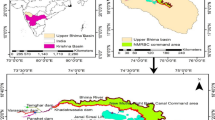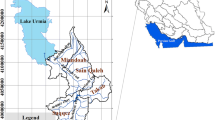Abstract
This paper focuses on extracting an optimal multi-crop pattern plan through multi-objective conjunctive surface-ground water use management. Minimizing shortages in meeting irrigation demands, maximizing groundwater resources sustainability and maximizing agricultural net benefits are the three main goals of the multi-objective optimization problem solved in this paper. A new robust fuzzy-based multi-objective PSO algorithm called f-MOPSO is adopted and modified to solve a three-objective real-world conjunctive use management problem presented in this paper after testing on standard test problems revealed f-MOPSO superiority as compared to the well-known multi-swarm vector evaluated PSO (VEPSO) algorithm. The f-MOPSO benefits from a well-organized Sugeno fuzzy inference system (SFIS) designed for handling multi-objective nature of the optimization problems. The unique performance of f-MOPSO is not only presenting the better final solutions, but also aggregating the capabilities for measurement of dominance and diversity of the solutions in one stage by one index named comprehensive dominance index, in contrast to a wide range of multi-objective algorithms that evaluate dominance and diversity in two separate stages resulting in excessive computational burden. The optimization model is carried out on a 10-year long-term simulation period, resulting in increasing irrigation efficiency i.e. decreasing water losses, decreasing water consumption per unit cultivated area and increasing water productivity compared to those similar criteria observed in actual operation in the study area. The wheat and rice crops were identified as the dominant crops, while the optimization model was the least interested to onion cultivation, assigning the least average cultivation area to this crop over the whole planning period.





Similar content being viewed by others
References
Abido MA (2010) Multiobjective particle swarm optimization with nondominated local and global sets. Nat Comput 9:747–766
Burt OR (1964) The economics of conjunctive use of ground and surface water. Hilgardia 36(2):25–41
Daneshmand F, Karimi A, Nikoo MR, Bazargan-Lari MR, Adamowski J (2014) Mitigating socio-economic-environmental impacts during periods by optimizing the conjunctive management of water resources. Water Resour Manag 28:1517–1529
De Paola F, Fontana N, Giugni M, Marini G, Pugliese F (2016) An application of the harmony-search multi-objective (HSMO) optimization algorithm for the solution of pump scheduling problem. Procedia Engineering:494–502. doi:10.1016/j.proeng.2016.11.093
Fallah-Mehdipour E, Bozorg Haddad O, Marino MA (2011) MOPSO algorithm and its application in multipurpose multireservoir operations. J Hydroinf 13(4):794–811
Heydari F, Saghafian B, Delavar M (2016) Coupled quantity-quality simulation-optimization model for conjunctive surface-groundwater use. Water Resour Manag. doi:10.1007/s11269-016-1426-3
Kennedy J, Eberhart R (1995) Particle swarm optimization. In: Proc international conference on neural networks, Perth. Australia. IEEE, Piscataway, NJ, pp 1942–1948
Lin Q, Li J, Du Z, Chen J, Ming Z (2015) A novel multi-objective particle swarm optimization with multiple search strategies. Eur J Oper Res 247:732–744
McPhee J, Yeh WW-G (2004) Multi objective optimization for sustainable groundwater management in semiarid regions. J Water Res Plan Manage ASCE 130(6):490–497
Mostaghim S, Teich J (2003) Strategies for finding good local guides in multi-objective particle swarm optimization (MOPSO). In IEEE Swarm Intelligence Symposium, IIN, April IEEE Service Center, Piscataway, NJ, pp 26–33
Moubayed NAI, Pertovski A, McCall J (2010) A novel smart multi-objective particle swarm optimization using decomposition. Parallel Problem Solving from Nature-PPSN XI, PTII, Lecture Notes in Computer Science 6239:1–10
Norouzzadeh MS, Ahmadzadeh MR, Palhang M (2012) LADPSO: using fuzzy logic to conduct PSO algorithm. Appl Intell 37:290–304
Parsopoulos KE, Vrahatis MN (2002) Particle swarm optimization method in multiobjective problems. In: In Proc. 2002 ACM symposium on applied computing, Madrid, Spain. March. ACM Press, Spain, pp 603–607
Peng W, Zhang QF (2008) A decomposition-based multi-objective particle swarm optimization algorithm for continuous optimization problems. In Proceedings of IEEE international conference on granular computing 534–537
Regulwar DG, Gurov JB (2011) Irrigation planning under uncertainty- a multi-objective fuzzy linear programming approach. Water Resour Manag 25:1387–1416
Rezaei F, Safavi HR, Mirchi A, Madani K (2017) F-MOPSO: an alternative multi-objective PSO algorithm for conjunctive water use management. J Hydro-Environ Res 14:1–18
Safavi HR, Esmikhani M (2013) Conjunctive use of surface water and groundwater: application of support vector machines (SVMs) and genetic algorithms. Water Resour Manag 27:2623–2644
Safavi HR, Rezaei F (2015) Conjunctive use of surface and ground water using fuzzy neural network and genetic algorithm. IJSTC 39(C2):365–377
Yekom Consulting Engineers (2013) Studies for updating Iran’s integrated water plan (Gavkhouni River Basin), Final report, Water and Wastewater section, Ministry of Energy (In Persian)
Zayandab Consulting Engineers (2008) Studies of water supplies and demands in the Zayandeh-Rud River Basin, The Preliminary Studies, 5th Volume, Agricultural Studies (In Persian)
Zeleny M (1973) Compromise programming, multiple criteria decision-making. In: Cochrane JL, Zeleny M (eds) Multiple criteria decision making. University of South Carolina Press, Columbia, pp 263–301
Author information
Authors and Affiliations
Corresponding author
Rights and permissions
About this article
Cite this article
Rezaei, F., Safavi, H.R. & Zekri, M. A Hybrid Fuzzy-Based Multi-Objective PSO Algorithm for Conjunctive Water Use and Optimal Multi-Crop Pattern Planning. Water Resour Manage 31, 1139–1155 (2017). https://doi.org/10.1007/s11269-016-1567-4
Received:
Accepted:
Published:
Issue Date:
DOI: https://doi.org/10.1007/s11269-016-1567-4




